Suikoden 1
A timeless JRPG with an expansive recruiting mechanic and no need for pointless grinding.

Overall
Suikoden was my first JRPG in half a decade, and it was a pleasant reintroduction to the genre.
Many fans of the series told me that I'd appreciate the lack of "grindiness" you'd find in a modern JRPG. Suikoden mostly fulfilled on this promise. Ocassionally the game's pacing is stilted, but the most time wasting activities in this game are a matter of accessibility, not gameplay design.
The Art Direction Is Incredible

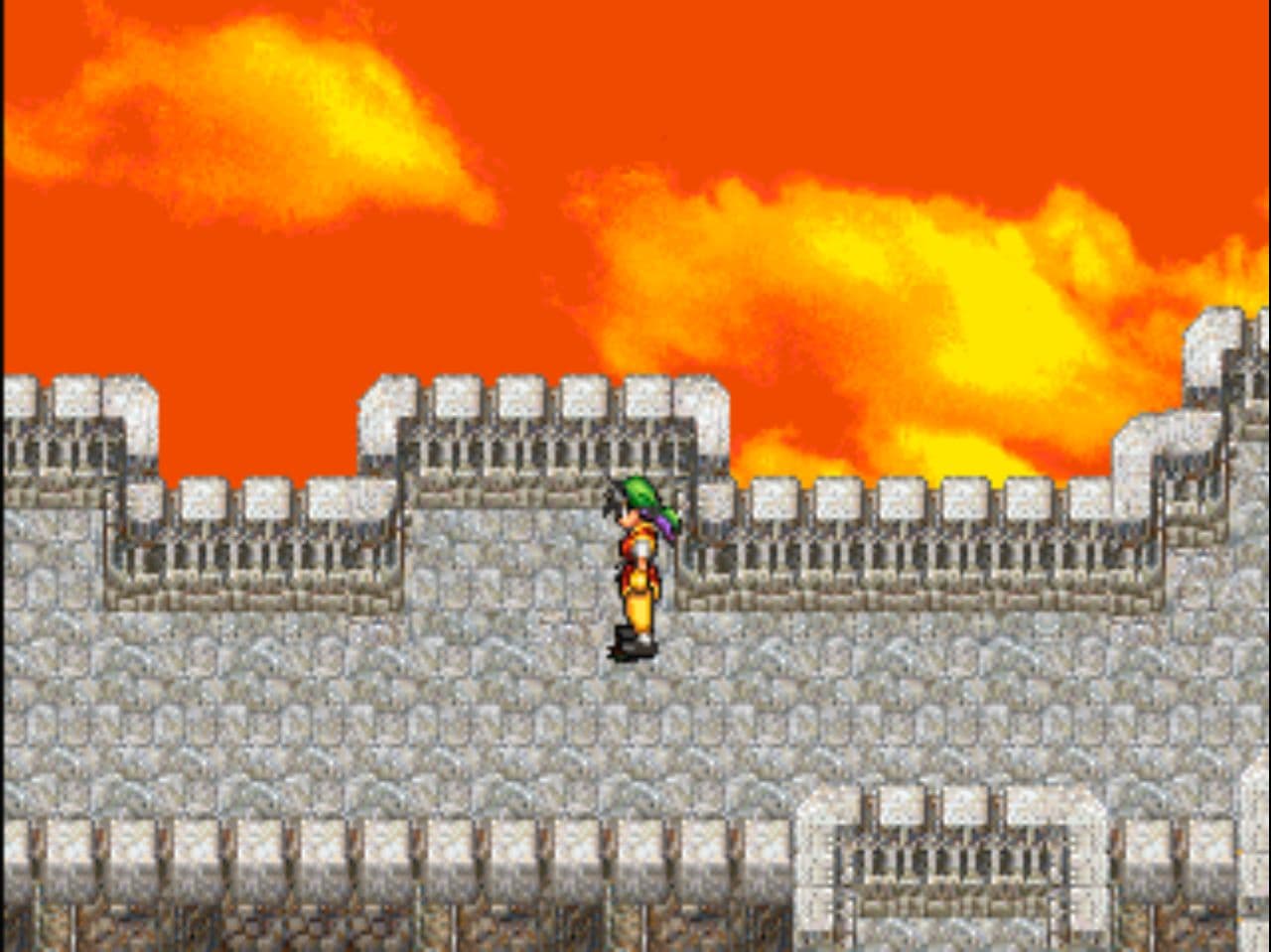
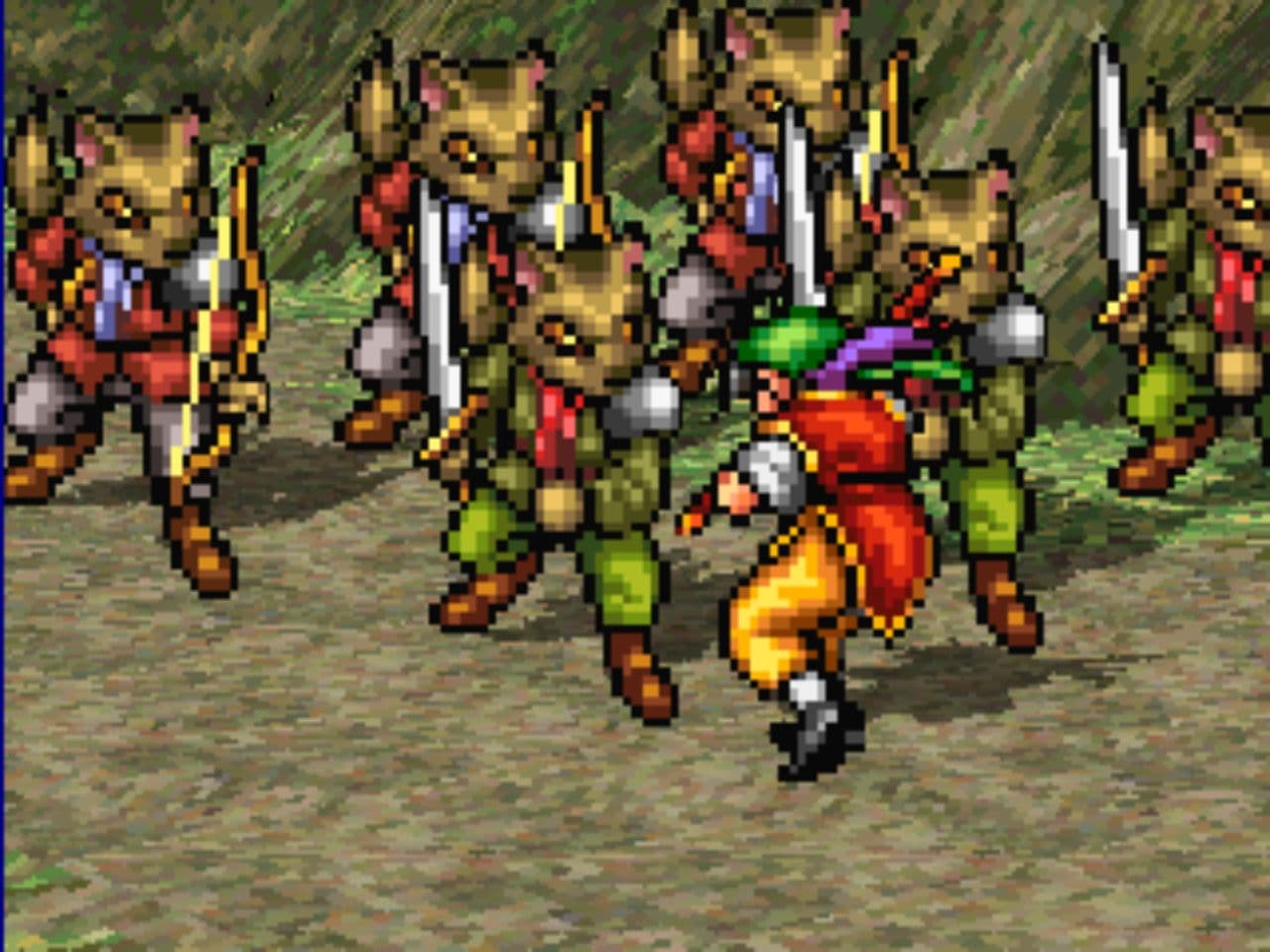

Suikoden makes clever use of visual design that is both pleasant to look at and adds to the believability of the world. The first example of this comes right when you launch the game. You spawn in a castle with floors so shiny you see your own reflection. It's a simple design choice that communicates the wealth and opulence of the capital, while also hinting towards the game's story theme of "looking into yourself".
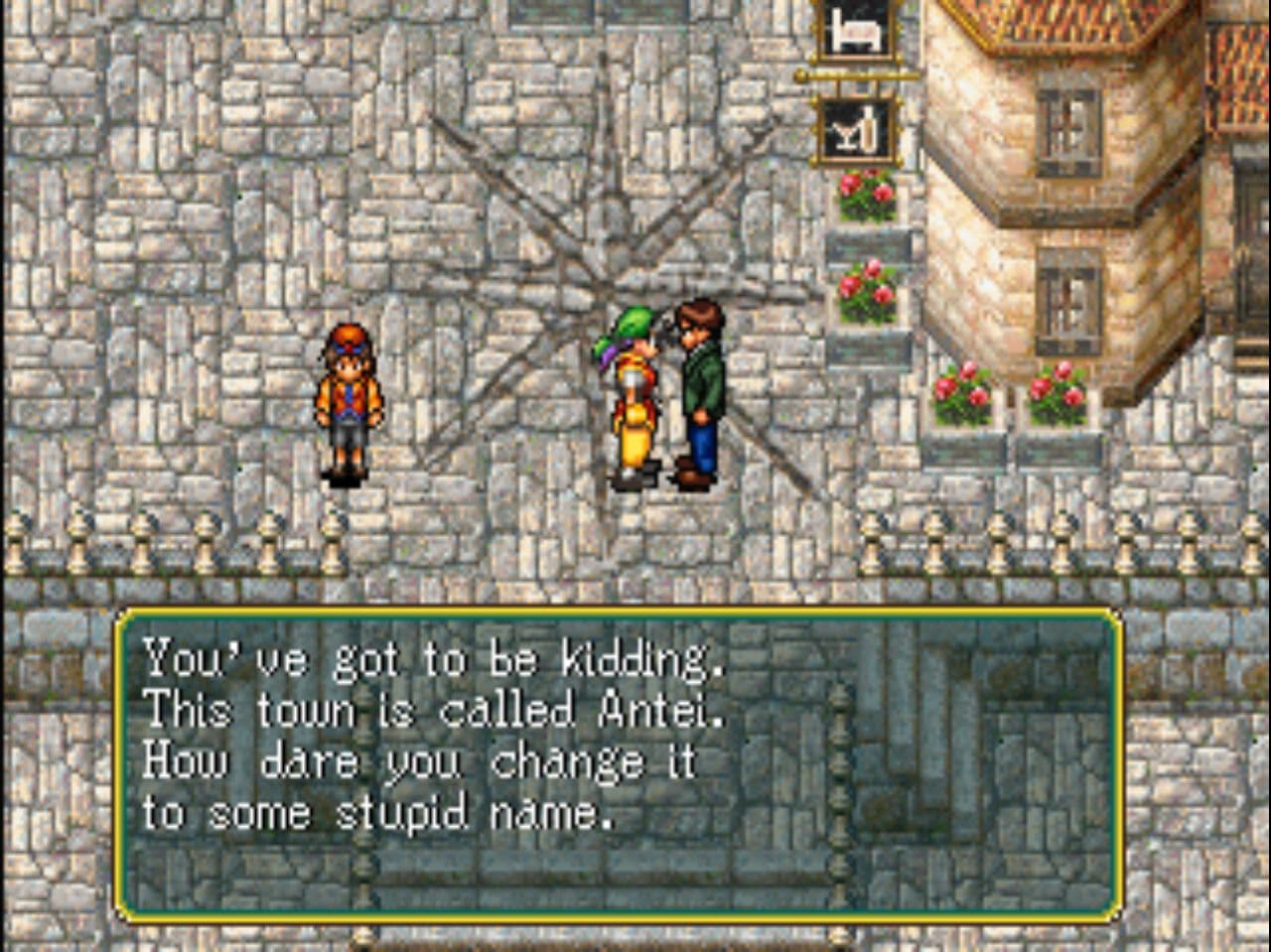
Antei's visual design and upbeat, tribal soundtrack make it very memorable.
Suikoden does its best visual world building with its enemy animations and combat camera. While the overworld is in 2D, combat takes place in a 3D space with characters and enemies rendered as billboard sprites. The 3D combat scenes open the door to interesting combat effects -- massive explosions, glowing spirit bombs, and gargantuan black holes.
The combat animations give enemies a lot of character. Most enemies will dodge a hit by hopping back quickly, but phantoms will sidestep in ghastly, ethereal forms. The snails you find on the mountain extend their long necks to hit you from a distance. Ghost warriors teleport behind you and backstab your rear guard during combat. A lot of thought was put into how the enemies will kill you beyond simple hacking and slashing. The enemy designs are fresh and interesting, and as we'll discuss in the gameplay section, you're never forced to look at the same enemies for too long.
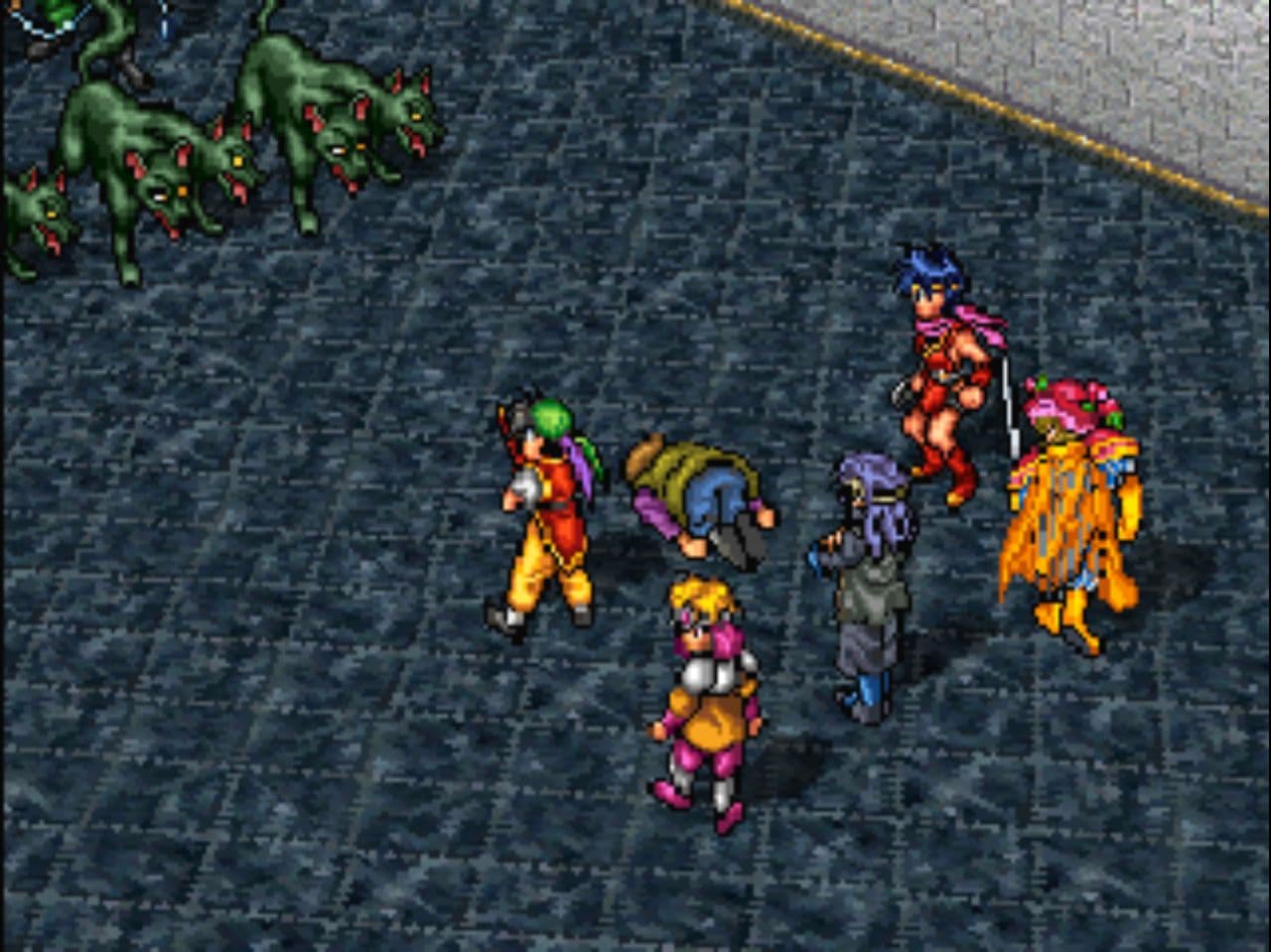
Krin's death pose is pathetic and in character.
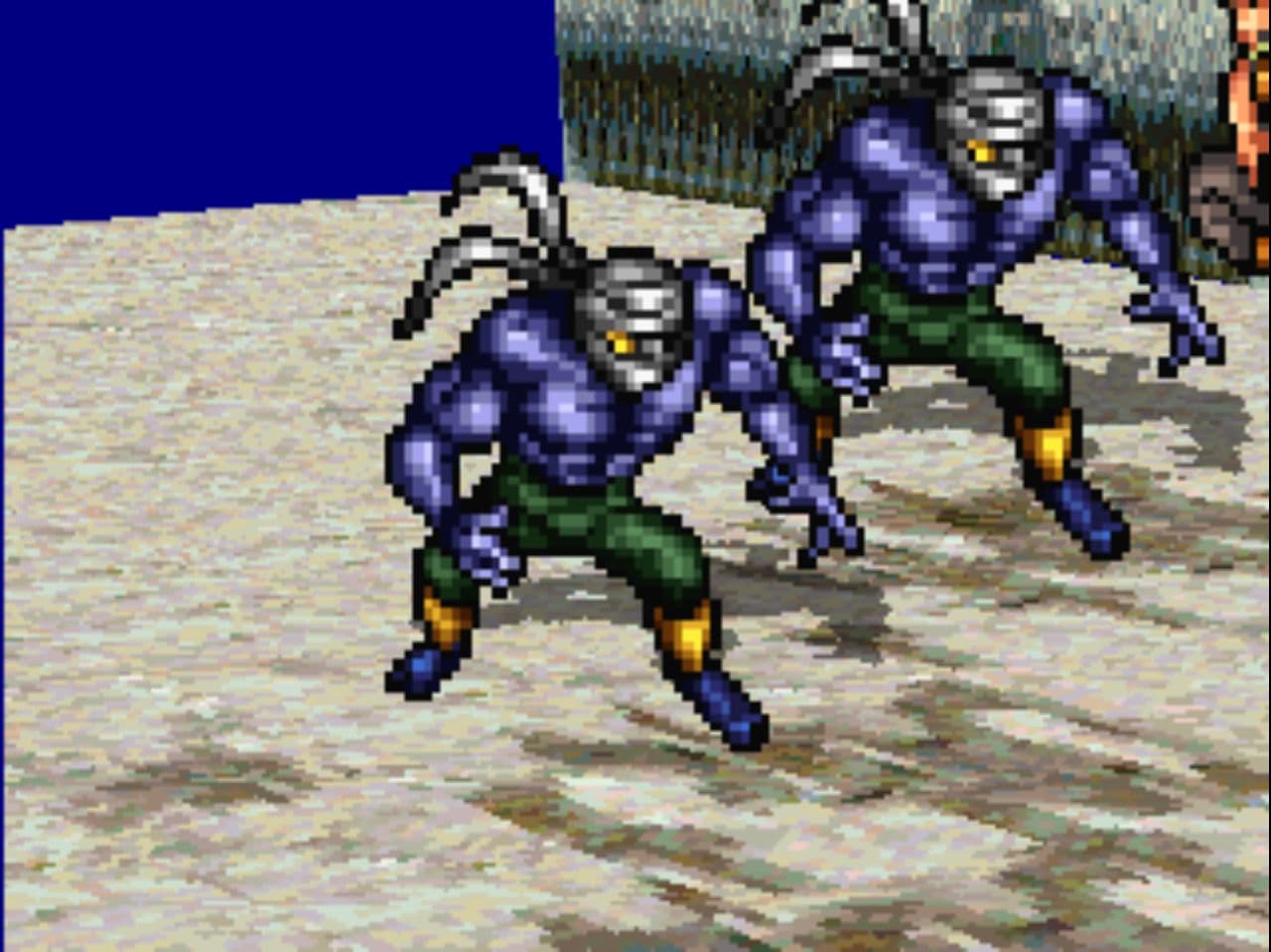
Look at how badass these demons are.
Image Compression Means The Art Lacks Fidelity
Despite the superior art direction, the fidelity of the art is far from first class, even considering the the 1994 hardware. The character portraits suffer from weird compression artifacts, and the out-of-combat sprites have this ever present bluriness that makes you want to clean your glasses. The sharpest renderings are the in-combat sprites and animations.
It's a massive game to fit on a 700MB CD-ROM. There are dozens of locations to explore and with 108 recruitable followers, all of them need their own combat sprites and animations, so all of the non-combat assets have the compression loss dialed up high. Since the combat is the best part of the game, they made the right call here.
The Soundtrack Is Well Done
Here's a link to a proper playlist separated by track.
I'd describe Suikoden's music as "medieval honky tonk." It has a characteristic MIDI feel, but makes good use of dynamics. It works well for the low fantasy setting and it builds the game's mood well.
The strength of its 58 song soundtrack is in its variety of textures. Many different instruments and timbres are used, but they all make sense for the world and setting. Primal, bass heavy drums and bongos fill out the lower ends for suspenseful pieces. While whimsical flute and trumpet themes keep you grounded in the fantasy setting when you're walking around town. The "Theme of Sadness" has deep, airy breaths accenting its main ideas. "An Old Irish Song" has the regal flare of staccato trumpets. Some creative banjo work even sneaks its way into the background of more tracks than I expected.
My personal favorite track is "Peaceful People", the song that plays when you visit Antei. The opening measures make heavy use of synths and bass, reminiscent of Halo's "Walk in the Woods" (a track I really like). But it takes you back into that fantasy feeling by moving into tribal vocals, bells, and high pitched strings. You hear these themes recycled at a different tempo in "Rising Tide".
Sometimes the layering can be too harsh and sudden, like in "Dancing Girl" and "People of Great Pride". These tracks have so many textures that it's disorienting, and the mix doesn't emphasize the primary voice of the constantly jumping phrases. They're still good tracks, but it's not the kind of music you're rearing to add to your favorite playlists. ("Peaceful People" is an example of Suikoden's layering done correctly -- the sounds are framed well by the mix and the variety of phrases keeps the track interesting).
I really didn't care much for the track that plays during the war minigame, "Collision". It's thematically appropriate, but ultimately sterile. I think it's supposed to draw focus to the fighting soldier sprites and dialogue from the mercenaries, but it fell flat for me and I wanted to mute it whenever it started playing. This track is one instance where I wish Suikoden would've taken on more of a rock influence.
Ambient Sound Effects Are Notably Missing
The ambient sound effects leave something to be desired. There's an occassional sound of water running or some environmental crunches, but you best get used to the soundtrack and menu sounds because it's 95% of what you'll be hearing.
The Gameplay Is Well Structured
The core gameplay loop is
- fight battles
- find recruits (there are a lot of them)
- build your recruits with skills and equipment
Fighting Battles Is Fun and Engaging

I really like how the snails extend to attack you.
Fighting battles is fun for the reasons discussed in the graphics section -- the enemy designs are pleasantly surprising and and the camera movement is cinematic. When a hero makes a ranged attack or uses a spell, the camera zooms out far so you see all the action. When you get a crit, it zooms up close to the enemy so you really feel the gravity of the hit. And if you choose "Free Will" during combat, everyone's actions will overlap and you get the sense that they're dogpiling the enemy in the frenzy of the battle. This is the game at its most enjoyable.
Strategy-wise, however, Free Will is an anti-pattern for harder group fights. To minimize damage, you often want to clear out packs of enemies one by one. Since Free Will distributes your damage among all of the enemies, you end up taking more damage than you should when you use it. The game is easy and it isn't a huge problem, but going from Free Will into fighting one by one is somewhat jarring and makes those battles feel like more of a slog.
The XP curve when fighting battles is very generous. When entering a new area, you gain a burst of XP on your first fights. Once you hit a certain level, that slows to a crawl, and the only way to level up is to go to the next area. This cuts back on the grindiness while encouraging the player to progress the plot. The generous XP curve is especially useful when leveling a new recruit. It only takes 2 or 3 fights to bring a fresh recruit up to a suitable level, a far cry from modern titles like Pokemon.
The healing is cheap and you don't need any special items to ressurect your allies out of combat, which saves a lot of time in the long run. Suikoden does its best not to waste your time with restrictive gameplay design.
Recruits and NPCs Make This Game Unique
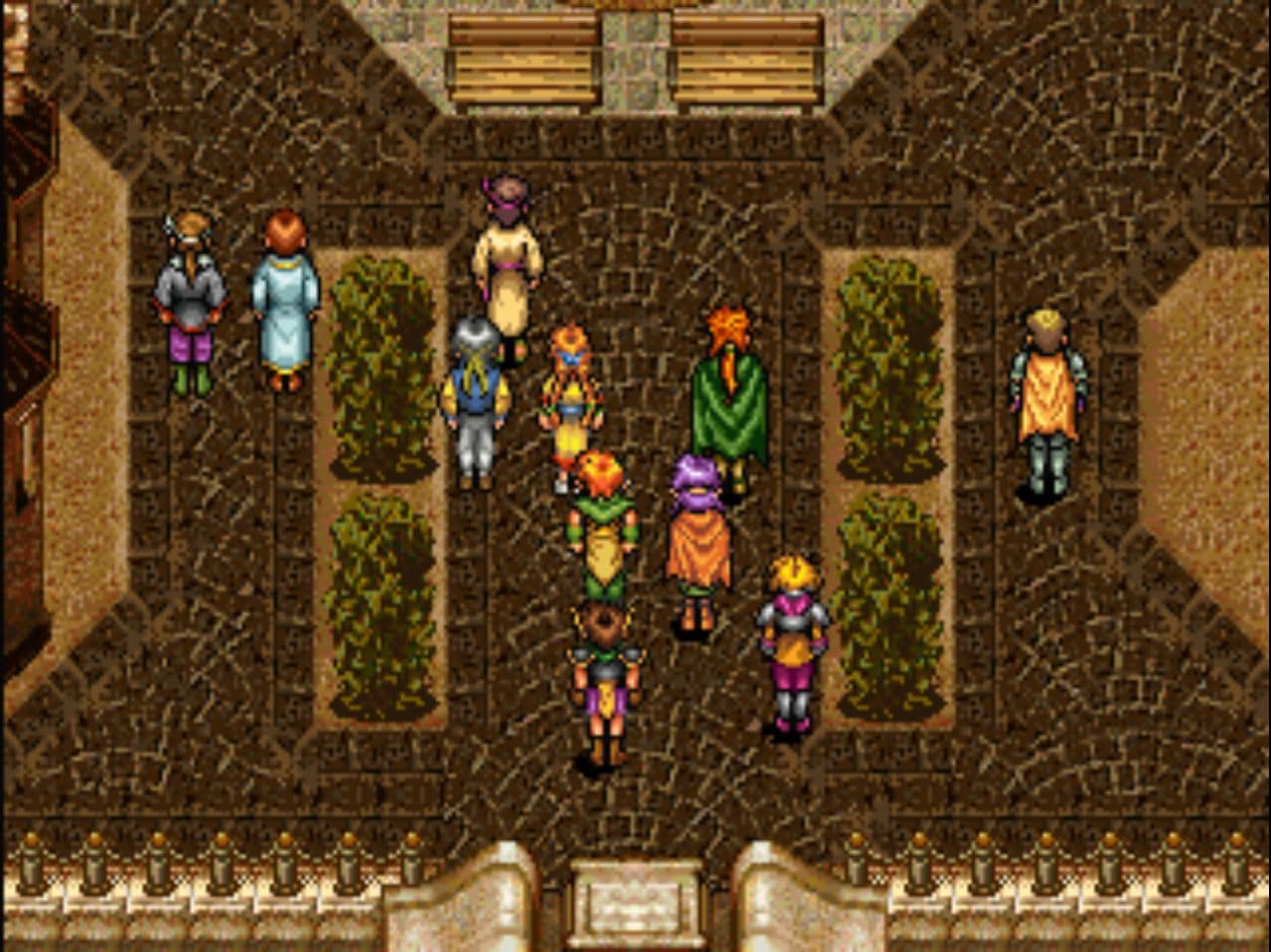
Suikoden has over 108 recruitable characters you can use in battle.
Finding recruits is Suikoden's hallmark as a JRPG. There are 108 possible party members, a staggering amount for any RPG. The game hints at this early with a character that says you need 50+ recruits before they'll join you. For the first couple of hours, you are given time to get used to the core plot characters, but once you get to the mid-game, you are given many opportunities to recruit fresh faces.
The character designs are memorable. Even though you won't use most of them, you could probably pick out their portrait from a line up and remember their backstory. Most characters have conditions for recruitment and not all of these are exciting, but they aren't unbearable for a completionist playthrough.
Throughout the game, talking to random NPCs is meaningful and necessary, if only to see if they're recruitable. Non-recruitable NPCs guide you to meaningful bits of lore or gameplay. Future plot beats will usually be set up by something you heard from an NPC. As you progress the story, you'll think things like "Oh, that explains what that old lady said." It happens often enough that it's worth it to talk to all of the townsfolk.
Skill/Equipment Builds Are Confusing
The skill and equipment builds are the most confusing part of the gameplay. I imagine the manual did most of the heavy lifting back in the day.
One thing I didn't understand at first was the distinction between "S", "M", and "L" characters. At first I thought it was equipment weight, but it actually refers to the character's attacking range. "Short" characters can only attack from the front row, "Mid" characters can attack from any row, and "Long" characters are the only characters that can hit the enemy's back row.
You won't be compelled to mess around with equipment. You can't equip any special weapons so items only raises your defense and gives you modest stat bonuses. The game is easy enough that you don't need to mess with it that often. It would be a nightmare optmizing more than a few characters anyway. The inventory management in this game is Dogshit with a capital D, which I'll discuss more in the accessiblity section.
The magic runes and crystals are the best part of character building. You can freely remove and attach them to different characters, and it's satisfying to see all of the 3D spell animations from a new crystal. It unfortunately suffers from the same inventory management issues, but that's minor compared to the payoff.
The War Minigames Are Mediocre
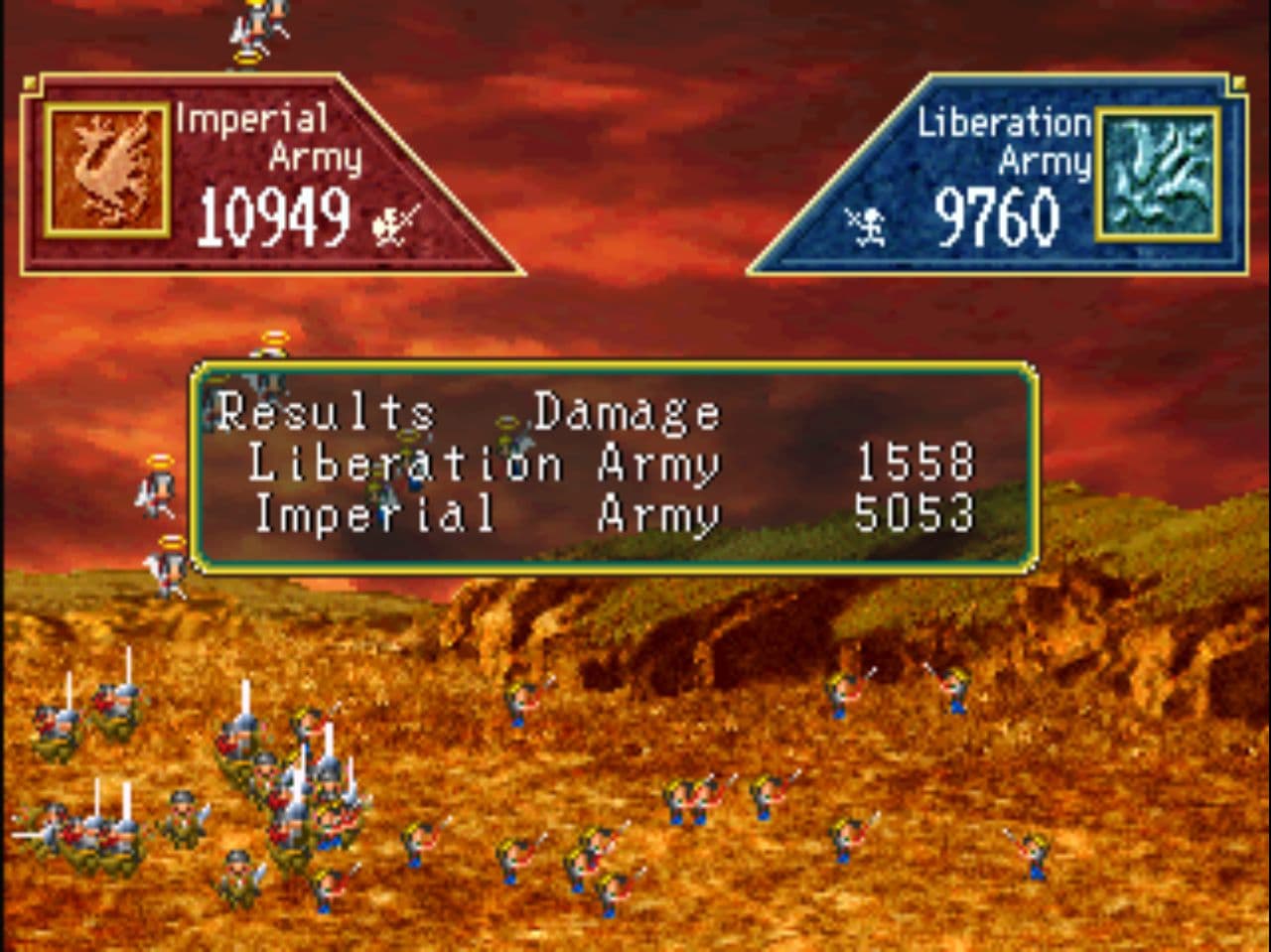
The war minigames have respectable backdrop variety.
Suikoden has war minigames where you clash your army into an enemy army. You get three actions: charge, bow, and magic, which boils down to a game of rock paper scissors. Charge beats bow, bow beats magic, and magic beats charge. They don't beat each other equally though -- if you use magic when the enemy charges, you won't lose any units at all. That's the only interaction where that's true.
These minigames suffer from a lack of interesting positional elements. And as mentioned before, I think the music isn't all that great even though the battles last 5+ minutes a piece. You do get to deploy the followers you've gained in these battles, but its more of a gimmick than a meaningful choice.
The game has some duel minigames that are also rock paper scissors. I like these for the cinematic camera movement, but they are rare and not too engaging in the grand scheme of things.
The Gambling Minigames Are A Fun Distraction
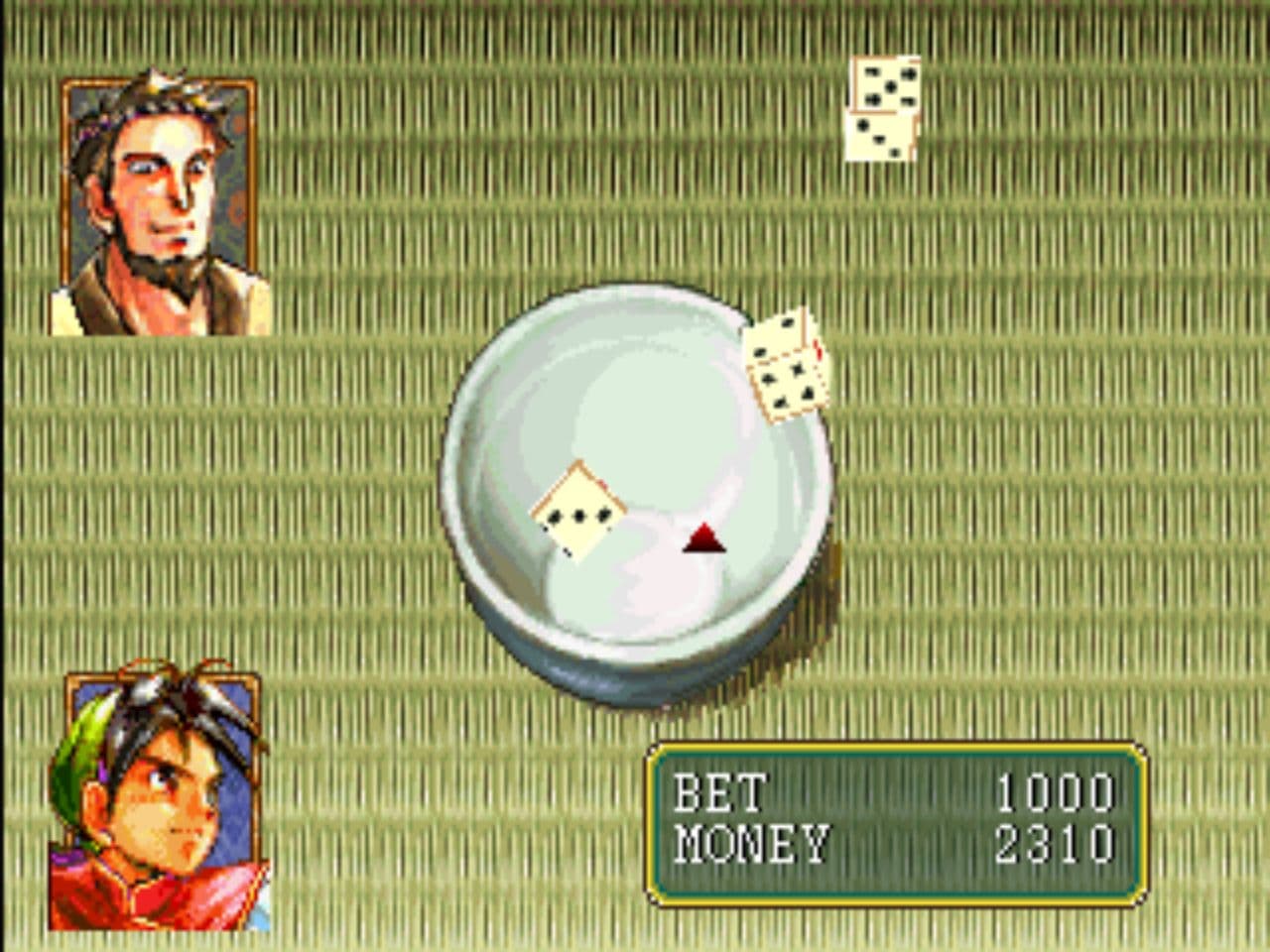
Suikoden has some fun gambling minigames mixed in.
There are also a few gambling minigames mixed in, which offer a pleasant change of pace from the usual combat scenery. I was impressed by the dice minigame. As a physics based minigame, it stood out from the game's other sections. The cups game is still my favorite.
The Story Is Okay
It's servicable and keeps the plot going, but it's not award winning writing. The game railroads many of your choices, but that's not my biggest issue with the story.
The game quickly suffers from character fatigue and has a habit of building setup without suitable payoff. Characters are given just enough screentime and backstory to make them relevant, but the sheer quantity of them means that none of them end up stealing the show. This is to be expected of a game with 108 recruitable followers.
The core characters get enough screen time to make them likable, but that's it. All of their characterization revolves around the player character, which makes them hard to appreciate.
Most followers in Suikoden have paper thin characterization, and the only reason they end up joining your army is "because the script said so." The followers' motivations are enough to be memorable, but none of them are compelling or thought provoking.
Since there are so many recruits, the game forces you to take certain party members at times. This lets them tell a predictable story without the chore of writing endless permutations of dialogue. There are only a few cases where an optional party member will interact directly with the plot. This isn't terrible, and the generous XP curve means you can accomodate forced characters into your party as needed.
The Story Has Good Pacing
Nothing you do ever feels like a grueling fetch quest. When you are tasked with clearing some dungeon or fetching a MacGuffin, it's always in an interesting new place that you're willing to explore. The story is enough to keep you motivated throughout the 20 hour campaign.
The Game Has Significant Accessibility Issues
When I consider accessibility, I ask myself, "Does the game have unplayable glitches?", "Are simple features easy to understand?", and "Are the features easy to use?". Suikoden is playable, but it has some issues that keep you from enjoying all the game has to offer.
The Inventory Management Is God Awful

My will to live after dealing with Suikoden's terrible inventory UI.
The inventory UI in this game is nightmare fuel. Characters have a dozen inventory slots, and all of their equipment will take up one of those slots. So a third of your inventory will always be full. And there is no way to simply trade items between two characters, which you will often have to do to put on new equipment. Trading to a character with a full inventory is a three step operation where you use another character as a buffer to hold the item. This means if all of your characters have a full inventory, you are unable to trade items between characters. The easiest way to manage inventory is to sell all of the old equipment to clear out space then buy the new stuff, which isn't a great solution.
You eventually get a storehouse for storing all of your items, but this also lacks a trade feature. Instead you get a "Detach" function which empties a benched character's entire inventory into the storehouse. This is annoying if you want to bring a character with you later, but then you remember they have no equipment when you dumped all their consumables. Then you have to deal with the nightmare of hunting down the compatible armor and accessories. It's not worth the time.
In Suikoden, upgrading your character equipment is like buying lots of groceries without a list. "Did I grab this? How much of that do I have left in the fridge? Did I get enough Mega Medicine for this character?" You're always going to forget something. Fortunately, the game is easy enough that you don't have to swap out equipment often, but these moments heavily break your momentum in the story.
Party Management Is A Massive Chore
Your characters don't heal or get their spells back when you swap them out, so sometimes you'll change out your party go into battle, then realize that they're all close to death. Resting at an inn doesnt heal your party for some reason -- it only restores their spell points. There are only a handful of "full rest" characters you can talk to that restore all of your HP and spells, but these are limited to special places like enemy castles. I'm sure you can recruit one of these characters for your castle, but I couldn't find one.
Switching party members has a long load time, probably to load the character portraits. There are separate menus for adding and removing from your party, and the game doesn't check if your party is full before committing to the load. A spinner and a quick validation check would've been appreciated here.

The only party that looked like any fun in Suikoden.
The Lack of UI Feedback Sometimes Feels Like A Bug
Later in the game, you get collectibles that you can turn in to special NPCs at your home base. You do this by talking to them with the collectibles in your inventory.
But there is no obvious feedback that you turned them in. Not even a line of dialogue from the characters. When this first happened, I thought, "What the hell? Did it delete them from my inventory?" But in reality, it just shows them to you on the trophy screen without any popup or notification. It's confusing and takes you out of the experience.
Other Minor Issues
There are some minor translation errors from the original Japanese. Complicated words get mistranslated and sometimes characters call each other by the wrong name. I played the Revision 1 version of the ROM, and I'm sure that the original release had more of these small glitches. However, these issues dwarf in comparison to the UI problems.
One gripe I have with the home base is there is no obvious save point. In Gregminster, you can save with the diary next to your bed, but for some reason this was not included in the castle. I still have not learned how you can save or heal in the castle.
Suikoden Is A Timeless, Enjoyable Experience, If A Little Dated
I liked Suikoden. It's a solid 4 out of 5 experience.
The art direction is well executed, and the lowest points of the games are just minor hiccups. If you're looking for a relatively short, enjoyable JRPG, Suikoden is definitely worth the time.
Watch my fully voice acted playthrough of Suikoden here.